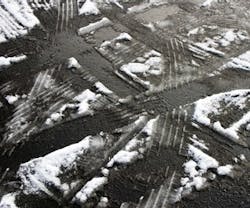From polluting waterways to damaging concrete, salt has a bad reputation. But during the winter, it’s still the cheapest and most effective deicing agent for clearing pathways and parking lots.
If your facility can’t make the transition to natural deicers, use rock salt responsibly to minimize its impact on the environment.
Problems with Salt Use
Salt’s popularity as a deicing agent is no surprise – it’s inexpensive, easy to use, abundantly available, and performs reliably when properly applied.
“It also works effectively to minimize the risk of injury to workers and slip-and-fall accidents,” says Roger McFadden, senior scientist with Staples.
But when used indiscriminately, salt deicers can cause a host of environmental problems:
- Contaminate waterways
- Kill landscaping
- Corrode metal building elements
- Damage uncured concrete
- Cause illness if ingested by children or pets
Avoid complications with salt deicers by applying them correctly, using blends, and deploying protective measures.
Salt Wisely
Salt deicers come with application rates that indicate how much product should be used per 1,000 square feet. Using more or less than recommended leads to ineffective melting and product mismanagement.
Beyond following the directions, consider anti-salting. Instead of salting your walkways after a snowfall, place salt out in anticipation of bad weather.
“The melter prevents the ice from bonding to the pavement by creating a brine,” explains Niles Hysell, ice melt director for Morton Salt. “The salt liquid is maintained underneath the accumulating snow and keeps melting.”
Anti-salting also uses less deicer than when applied over accumulation. The downside is that you must be proactive about your weather situation and make decisions in advance.
Take Protective Measures
While it’s possible to use organic deicers or heated mats, it’s not always practical or cost effective. There are a number of measures you can take to protect your property from the caustic effects of salt.
“Don’t put deicers on any concrete that’s less than a year old because it hasn’t cured yet,” says Hysell. If you do, it will damage the concrete beyond repair.
“I’ve seen properties where they’ve had to take out the entire sidewalk area the next year to replace it,” cautions McFadden.
Have good matting leading up to the building and several feet into your entrance.
“Make sure the length extends 6 to 10 feet into the building to capture the first four or five steps of people tracking in deicer,” McFadden says.
This will help to absorb melting liquids and prevent the salt from becoming embedded into flooring. You can further protect floor finishes with neutralizers, such as sodium bicarbonate or citric acid solutions.
If you contract your maintenance services or snow removal, ensure that your RFT addresses your expectations for salt deicers. Don’t assume your vendor is anti-salting or using blends without your prompting.
Mix It Up With Blends
Accurate temperature readings are critical when deciding which deicer to use. Remember that the temperatures on the weather station can be 10 degrees higher than the actual surface temperature, cautions Hysell.
One of the drawbacks of rock salt (sodium chloride) is that its melting capacity is only effective between 15-20 degrees F. and over. An increased volume won’t improve the melting and amplifies the likelihood of environmental damage.
Your best bet is to have a number of blends on hand to address different temperature ranges or levels of sensitivity around your property. Calcium chloride, urea (a fertilizer), and magnesium chloride are common additives that boost sodium chloride’s performance.
“Rather than using pure rock salt, you can combine it with calcium chloride,” McFadden recommends. “This will improve the efficiency because calcium chloride is hygroscopic – it generates heat when it transfers from a solid to a liquid.”
This also saves money because using one of these additives alone is costly. Cutting it with salt will get the best mileage out of both materials.
Jennie Morton ([email protected]) is associate editor of BUILDINGS.
About the Author
Jennie Morton
A former BUILDINGS editor, Jennie Morton is a freelance writer specializing in commercial architecture, IoT and proptech.
